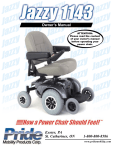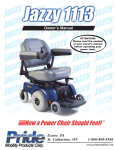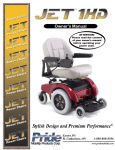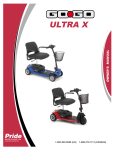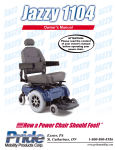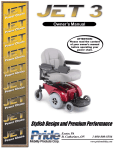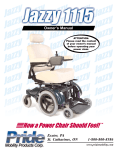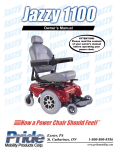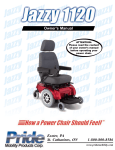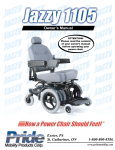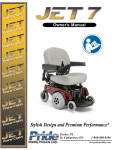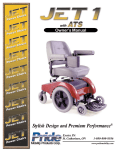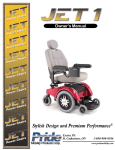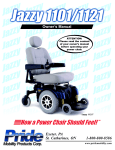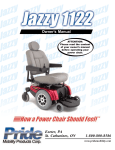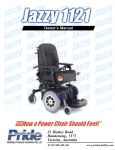Download Pride Mobility JAZZY 1103 Owner`s manual
Transcript
Owner’s Manual ATTENTION: Please read the content of your owners manual before operating your power chair. Exeter, PA St. Catharines, ON www.pridemobility.com SAFETY GUIDELINES Please read and follow all instructions in this owners manual before attempting to operate your power chair for the first time. If there is anything in this manual you do not understand, or if you require additional assistance for set-up, contact your authorized Pride provider. Using your Pride product safely depends upon your diligence in following the warnings, cautions, and instructions in this owners manual. Using your Pride product safely also depends upon your own good judgement and/or common sense, as well as that of your provider, caregiver, and/or healthcare professional. Pride is not responsible for injuries and/or damage resulting from any persons failure to follow the warnings, cautions, and instructions in this owners manual. Pride is not responsible for injuries and/or damage resulting from any persons failure to exercise good judgement and/or common sense. The symbols below are used throughout this owners manual to identify warnings and cautions. It is very important for you to read and understand them completely. WARNING! Failure to heed the warnings in this owners manual may result in personal injury. CAUTION! Failure to heed the cautions in this owners manual may result in damage to your power chair. Copyright © 2003 Pride Mobility Products Corp. INFMANU 1182 2 www.pridemobility.com Jazzy 1103 Rev L/Feb03 CONTENTS I. INTRODUCTION.......................................................................................... 4 II. SAFETY ...................................................................................................... 6 III. EMI/RFI ..................................................................................................... 13 IV. THE JAZZY 1103 ..................................................................................... 15 V. COMFORT ADJUSTMENTS ...................................................................... 20 VI. BATTERIES AND CHARGING .................................................................... 24 VII. OPERATION .............................................................................................. 28 VIII. CARE AND MAINTENANCE ....................................................................... 35 IX. OPTIONS AND ACCESSORIES ................................................................. 40 X. WARRANTY .............................................................................................. 43 Jazzy 1103 Rev L/Feb03 www.pridemobility.com 3 I. INTRODUCTION INTRODUCTION Welcome to Pride Mobility Products Corporation (Pride). Congratulations on the purchase of your new Pride Power Chair. The Pride Power Chair design combines the most advanced state-of-the-art components with modern, attractive styling. We are certain that the design features and trouble-free operation of your new power chair will add convenience to your daily living. At Pride, your safety is important to us. Please read and follow all of the instructions in this manual before you attempt to operate your power chair for the first time. These instructions were produced for your benefit. Your understanding of these instructions is essential for the safe operation of your new power chair. Pride is not liable for damage to property or personal injury arising out of unsafe use of a power chair. Pride is also not liable for any property damage or personal injury arising out of the failure of any person and/or user to following the instructions and recommendations set forth in this manual or any other instructions or recommendations contained in other power chair related literature issued by Pride or contained on the power chair itself. This owners manual is compiled from the latest specifications and product information available at the time of publication. We reserve the right to make changes as they become necessary. Any changes to our products may cause slight variations between the illustrations and explanations in this manual and the product you have purchased. If you experience any problems with your power chair that you are unable to solve, or if you do not feel capable of safely following any of the instructions and/or recommendations as contained in this manual, please contact your authorized Pride provider for assistance. Once you understand how to operate and take care of your power chair, we are certain that it will give you years of trouble-free service and enjoyment. Information Exchange We want to hear your questions, comments, and suggestions about this manual. We would also like to hear about the safety and reliability of your new power chair, and about the service you received from your authorized Pride provider. Please notify us of any change of address, so we can keep you apprised of important information about safety, new products, and new options that can increase your ability to use and enjoy your power chair. Please feel free to contact us at the address below: Pride Mobility Products Corporation Attn: Customer Care Department 182 Susquehanna Avenue Exeter, PA 18643-2694 [email protected] 800-424-8205 4 www.pridemobility.com Jazzy 1103 Rev L/Feb03 I. INTRODUCTION Pride Owners Club As an owner of a Pride product, you are invited to register your products warranty and enroll in the Pride Owners Club. You may do so by filling out and returning your enclosed registration card or by visiting Prides web site at www.pridemobility.com. As a registered member, each time you visit our site, you will have access to the most interactive and honest educational venue available today for people with mobility needs, their families, and friends. From our home page, select Owners Club to enter a page dedicated to current and potential Pride product owners. You will gain access to interviews, stories, recreation ideas, daily living tips, product and funding information, and interactive message boards. These message boards invited you to communicate with other Pride customers as well as Pride representatives who are available to assist you with any questions or concerns you may have. My Authorized Pride Provider Is: Name:_______________________________________________________________________________ Address:_____________________________________________________________________________ Phone Number:________________________________________________________________________ Purchase Date:________________________________________________________________________ NOTE: If you ever lose or misplace your product registration card or your copy of this manual, contact us and we will be glad to send you a new one immediately. Jazzy 1103 Rev L/Feb03 www.pridemobility.com 5 II. S AFE T Y SAFETY WARNING! Do not operate your new power chair for the first time without completely reading and understanding this owners manual. Your power chair is a state-of-the-art life-enhancement device designed to increase mobility. Pride provides an extensive variety of products to best fit the individual needs of the power chair user. Please be aware that the final selection and purchasing decision regarding the type of power chair to be used is the responsibility of the power chair user, who is capable of making such a decision, and his/her healthcare professional (i.e., medical doctor, physical therapist, etc.). The contents of this manual are based on the expectation that a mobility device expert has properly fitted the power chair to the user and has assisted the prescribing healthcare professional and/or the authorized Pride provider in the instruction process for the use of the product. There are certain situations, including some medical conditions, where the power chair user will need to practice operating the power chair in the presence of a trained attendant. A trained attendant can be defined as a family member or care professional specially trained in assisting a power chair user in various daily living activities. As you begin using your power chair during daily activities, you will probably encounter situations in which you will need some practice. Simply take your time and you will soon be in full and confident control as you maneuver through doorways, on and off of elevators, up and down ramps, and over moderate terrain. Below are some precautions, tips, and other safety considerations that will help the user become accustomed to operating the power chair safely. Modifications Pride has designed and engineered your power chair to provide maximum mobility and utility. A wide range of accessories is available from your authorized Pride provider to further customize your power chair to better suit your needs and/or preferences. However, under no circumstances should you modify, add, remove, or disable any feature, part, or function of your power chair. WARNING! Do not modify your power chair in any way not authorized by Pride. Unauthorized modifications may result in personal injury and/or damage to your power chair. Pre-Ride Safety Check Get to know the feel of your power chair and its capabilities. Pride recommends that you perform a safety check before each use to make sure your power chair operates smoothly and safely. See VIII. Care and Maintenance. Perform the following inspections prior to using your power chair: n Check for proper tire inflation. Maintain 30-35 psi in each tire (if equipped with pneumatic tires). n Check all electrical connections. Make sure they are tight and not corroded. n Check all controller connections to the electronics tray. Make sure they are secured properly. n Check the brakes. See VIII. Care and Maintenance. n Check battery charge. See VI. Batteries and Charging. 6 www.pridemobility.com Jazzy 1103 Rev L/Feb03 II. SAFETY NOTE: If you discover a problem, contact your authorized Pride provider for assistance. Weight Limitations Your power chair is rated for a maximum weight capacity. Please refer to the specifications table for this limit. WARNING! Exceeding the weight capacity voids your warranty and may result in personal injury and/or damage to your power chair. Pride will not be held responsible for injuries and/or property damage resulting from failure to observe weight limitations. WARNING! Do not carry passengers on your power chair. Carrying passengers on your power chair may result in personal injury and/or property damage. Tire Inflation If your power chair is equipped with pneumatic tires, you should check or have the air pressure checked at least once a week. Proper inflation pressures will prolong the life of your tires and help ensure the smooth operation of your power chair. WARNING! It is important that 30-35 psi tire pressure be maintained in pneumatic tires at all times. Do not underinflate or overinflate your tires. Low pressure may result in loss of control, and overinflated tires may burst. Failure to maintain 30-35 psi tire pressure in pneumatic tires at all times may result in tire and/or wheel failure, causing serious personal injury and/or damage to your Jazzy. WARNING! Inflate your power chair drive tires from a regulated air source with an available pressure gauge. Inflating your tires from an unregulated air source could overinflate them, resulting in a burst tire and/or personal injury. Incline Information More and more buildings have ramps with specified degrees of inclination, designed for easy and safe access. Some ramps may have turning switchbacks (180-degree turns) that require you to have good cornering skills on your power chair. n Proceed with extreme caution as you approach the downgrade of a ramp or other incline. n Take wide swings with your power chairs front wheels around any tight corners. If you do that, the power chairs rear wheels will follow a wide arc, not cut the corner short, and not bump into or get hung up on any railing corners. n When driving down a ramp, keep the power chairs speed adjustment set to the slowest speed setting to ensure a safely controlled descent. See VII. Operation. n Avoid sudden stops and starts. When climbing an incline, try to keep your power chair moving. If you must stop, start up again slowly and then accelerate cautiously. When driving down an incline, set your power chair to the slowest setting and drive in the forward direction only. If your power chair starts to move down the incline faster than you anticipated or desired, allow it to come to a complete stop by releasing the joystick, then push the joystick forward slightly to ensure a safely controlled descent Jazzy 1103 Rev L/Feb03 www.pridemobility.com 7 II. SAFETY WARNING! When climbing an incline, do not zigzag or drive at an angle up the face of the incline. Drive your power chair straight up the incline. This greatly reduces the possibility of a tip or a fall. Always exercise extreme caution when negotiating an incline. WARNING! You should not travel up or down a potentially hazardous incline (i.e., areas covered with snow, ice, cut grass, or wet leaves). WARNING! When on any sort of an incline or decline, never place the power chair in freewheel mode while seated on it or standing next to it. Doing so may result in personal injury and/or damage to your power chair. WARNING! Never travel down an incline backwards. This may result in personal injury. WARNING! Even though your power chair is capable of climbing slopes greater than those illustrated in figures 1 and 2, do not, under any circumstances, exceed the incline guidelines or any other specifications presented in this manual. Doing so could cause instability in your power chair, resulting in personal injury and/or damage to your power chair. In compliance with the Americans with Disabilities Act of 1990, all handicap public access ramps are required to have a maximum slope of 5°. Therefore, Pride recommends that the maximum slope of an incline you attempt to safely ascend or descend on your power chair does not exceed 5°. See figure 1. WARNING! Any attempt to climb or descend a slope steeper than 5° may put your power chair in an unstable position and cause it to tip, resulting in personal injury. Figure 1. Maximum Safe Angle (Ascending and Descending) Braking Information Your power chair is equipped with two powerful brake systems: 1. Regenerative uses electricity to rapidly slow the vehicle when the joystick returns to the center/stop position. 2. Disc Park Brake activates mechanically after regenerative braking slows the vehicle to near stop, or when power is removed from the system for any reason. Cornering Information While your power chair is equipped with rear caster wheels in back and anti-tip wheels in front, excessively high cornering speeds can still create the possibility of tipping. Factors which affect the possibility of tipping include, but are not limited to: cornering speed, steering angle (how sharply you are turning), uneven road surfaces, inclined road surfaces, riding from an area of low traction to an area of high traction (such as passing from a grassy area to a paved area especially at high speed while turning), and abrupt directional changes. High cornering speeds are not recommended. If you feel that you may tip over in a corner, reduce your speed and steering angle (i.e., lessen the sharpness of the turn) to prevent your power chair from tipping. WARNING! When cornering sharply, reduce your speed. This greatly reduces the possibility of a tip or fall. To avoid personal injury and/or property damage, always exercise common sense when cornering. 8 www.pridemobility.com Jazzy 1103 Rev L/Feb03 II. SAFETY Outdoor Driving Surfaces Your power chair is designed to provide optimum stability under normal driving conditionsdry, level surfaces composed of concrete, blacktop, or asphalt. However, Pride recognizes that there will be times when you will encounter other surface types. For this reason, your power chair is designed to perform admirably on packed soil, grass, and gravel. Feel free to use your power chair safely on lawns and in park areas. n Reduce your power chairs speed when driving on uneven terrain and/or soft surfaces. n Avoid tall grass that can entangle the running gear. n Avoid loosely packed gravel and sand. n If you feel unsure about a driving surface, avoid that surface. Freewheel Mode Your power chair is equipped with two manual freewheel levers to allow for manual maneuverability by a trained attendant. For more information about how to place your power chair into and out of freewheel mode, see IV. The Jazzy 1103. WARNING! Do not use your power chair in freewheel mode without an attendant present. Personal injury may result. WARNING! Do not attempt to personally place your power chair in freewheel mode while seated on it. Personal injury may result. Ask an attendant for assistance if necessary. WARNING! Do not place your power chair in freewheel mode while on an incline. The chair could roll uncontrollably on its own, causing personal injury. Stationary Obstacles (Steps, Curbs, etc.) Proceed with extreme caution when driving near raised surfaces, unprotected ledges and/or drop-offs (curbs, porches, stairs, etc.). The correct method for approaching a curb is illustrated in figure 1a. WARNING! Do not attempt to have your power chair climb or descend an obstacle that is higher than two inches unless you have the assistance of an attendant. WARNING! Do not attempt to have your power chair proceed backward down any step, curb, or other obstacle. This may cause the power chair to tip and cause personal injury. Figure 1a. Curb Approach (Correct and Incorrect) Jazzy 1103 Rev L/Feb03 www.pridemobility.com 9 II. SAFETY Public Streets and Roadways WARNING! You should not operate your power chair on public streets and roadways. Be aware that it may be difficult for traffic to see you when you are seated on your power chair. Obey all local pedestrian traffic rules. Wait until your path is clear of traffic, and then proceed with extreme caution. Stairs and Escalators Power chairs are not designed to travel up or down stairs or escalators. Always use an elevator. WARNING! Never use your power chair to negotiate steps or escalators. You may cause injury to yourself and to others and/or damage your power chair. Doors n Determine if the door opens toward or away from you. n Drive your power chair gently and slowly forward to push the door open. Or drive your power chair gently and slowly backward to pull the door open. Elevators Modern elevators have a door edge safety mechanism that, when pushed, reopens the elevator door(s). n If you are in the doorway of an elevator when the door(s) begin to close, push on the rubber door edge or allow the rubber door edge to contact the power chair and the door will reopen. n Use care that pocketbooks, packages, or power chair accessories do not become caught in elevator doors. EMI & RFI Laboratory tests performed by the Food and Drug Administration (FDA) have shown that radio waves can cause unintended motion of electric mobility vehicles. Radio waves are a form of electromagnetic energy (EM). When EM adversely affects the operation of an electronic device, it is called Electromagnetic Interference (EMI) or Radio Frequency Interference (RFI). For more information, see III. EMI/RFI. Lift/Elevation Products If you will be traveling with your power chair, you may find it necessary to use a lift/elevation product to aid in transportation. Pride recommends that you closely review the instructions, specifications, and safety information set forth by the manufacturer of the lift/elevation product before using that product. Motor Vehicle Transport Currently, there are no standards approved for tie-down systems in a moving vehicle of any type to transport a person while seated in a power chair. Transfers Transferring onto and off of your power chair requires a good sense of balance. Always have an attendant or healthcare professional present while learning to properly transfer yourself. 10 www.pridemobility.com Jazzy 1103 Rev L/Feb03 II. SAFETY To eliminate the possibility of injury, Pride recommends that you or a trained attendant perform the following tasks before attempting a transfer: n Turn the power off. See VII. Operation. n Ensure your power chair is not in freewheel mode. See IV. The Jazzy 1103 n Turn both caster wheels toward the transfer destination to improve power chair stability during transfer. n Make sure both armrests are flipped up or removed from your power chair. n Flip the footrest up, or move the leg rests aside; this will help to keep your feet from getting caught on the footrest or the leg rests during the transfer. n Reduce the distance between your power chair and the object you are transferring onto. WARNING! Before transferring, position yourself as far back as possible in the power chair seat to prevent the power chair from tipping forward during transfer and causing injury. WARNING! Avoid using your armrests for weight bearing purposes. Such use may cause the power chair to tip and cause personal injury. WARNING! Avoid putting all of your weight on the footrest. Such use may cause the power chair to tip and cause personal injury. Positioning Belts Your authorized Pride provider, therapist(s), and other healthcare professionals are responsible for determining your requirement for a positioning belt in order to operate your power chair safely. WARNING! If you require a positioning belt to safely operate your power chair, make sure it is fastened securely. Serious personal injury may result if you fall from the power chair. WARNING! The positioning belt is not designed for use as a seat belt in a motor vehicle. Nor is your Jazzy suitable for use as a seat in any vehicle. Anyone traveling in a vehicle should be properly belted into seats approved by the vehicle manufacturer. WARNING! Do not sit on your power chair while it is in a moving vehicle. Personal injury and/or property damage may result. WARNING! Always be sure your power chair and its batteries are properly secured when it is being transported. Failure to do so may result in personal injury and/or damage to your power chair. Inclement Weather Precautions WARNING! Pride recommends that you do not operate your power chair in icy or slippery conditions or on salted surfaces (i.e., walks or roads). Such use may adversely affect the performance and safety of your power chair, resulting in an accident and personal injury. WARNING! Do not expose your power chair to any type of moisture at any time (rain, snow, mist, or wash). Such exposure can damage your power chair. Never operate your power chair if it has been exposed to moisture until it has dried thoroughly. Jazzy 1103 Rev L/Feb03 www.pridemobility.com 11 II. SAFETY Reaching and Bending Never reach, lean, or bend while driving your power chair. If it is absolutely necessary to reach, lean, or bend while seated on your power chair, it is important to maintain a stable center of gravity and keep the power chair from tipping. Pride recommends that the power chair user determine his/her personal limitations and practice bending and reaching in the presence of a qualified healthcare professional. WARNING! Do not bend, lean, or reach for objects if you have to pick them up from the floor by reaching down between your knees. Movements such as these may change your center of gravity and the weight distribution of the power chair. This may cause your power chair to tip, possibly resulting in personal injury. Keep your hands away from the tires when driving. Batteries In addition to following the warnings below, be sure to comply with all other battery handling information. For more information about your power chairs batteries, see VI. Batteries and Charging. WARNING! Power chair batteries are heavy. See specifications table. If you are unable to lift that much weight, be sure to get help. Lifting beyond your capacity can result in personal injury. WARNING! Battery posts, terminals, and related accessories contain lead and lead compounds. Wash hands after handling. WARNING! Always protect the batteries from freezing and never charge a frozen battery. Charging a frozen battery may result in personal injury and/or damage to the battery. Preventing Unintended movement WARNING! If you anticipate being seated in a stationary position for an extended period of time, turn off the power. This will prevent unexpected motion from inadvertent joystick contact. This will also eliminate the possibility of unintended chair movement from electromagnetic (EM) sources. Failure to do so may result in personal injury. Prescription Drugs/Physical Limitations Users must exercise care and common sense when operating a power chair. This includes awareness of safety issues when taking prescribed or over-the-counter drugs or when the user has specific physical limitations. WARNING! Consult your physician if you are taking prescribed or over-the-counter medication or if you have certain physical limitations. Some medications and limitations may impair your ability to operate your power chair in a safe manner. Alcohol The power chair user must exercise care and common sense when operating his/her power chair. This includes awareness of safety issues while under the influence of alcohol. WARNING! Do not operate your power chair while you are under the influence of alcohol, as this may impair your ability to operate your power chair in a safe manner. Removable Parts WARNING! Do not attempt to lift or move a power chair by any of its removable parts. Personal injury and/or damage to the power chair may result. 12 www.pridemobility.com Jazzy 1103 Rev L/Feb03 I I I . E M I / R F I Laboratory tests performed by the Food and Drug Administration (FDA) have shown that radio waves can cause unintended motion of power chairs. Radio waves are a form of electromagnetic energy. When this energy adversely affects the operation of an electronic device, it is called Electromagnetic Interference (EMI) or Radio Frequency Interference (RFI). WARNING! Radio waves may interfere with the control of power chairs. EMI/RFIFREQUENTLY ASKED QUESTIONS (FAQS) The following FAQs summarize what you should know about EMI/RFI. Use this information to minimize the risk that EMI/RFI will affect your power chair. Where do radio waves come from? Radio waves are emitted from the antennas of cellular phones, mobile two-way radios (such as walkie-talkies), radio stations, TV stations, amateur radio (HAM) transmitters, wireless computer links, microwave sources, and paging transmitters. Radio waves are a form of electromagnetic energy (EM). Because electromagnetic energy is more intense closer to the transmitting antenna (source of emission), the EM fields from two-way radios are of special concern to power chair users. If my power chair is affected by EMI/RFI, what kind of motion should I expect? This is hard to predict. It would depend on a number of factors: n Strength of the radio waves n Construction of the power chair n Position of the power chair (whether it is on level ground or on an incline) n Whether or not the power chair is in motion An affected power chairs movement can be erratic. It may move by itself or come to a sudden stop. Furthermore, it is possible for EMI/RFI to unexpectedly release the brakes on a power chair. Some intense sources of EMI/RFI can even damage the control system of the Jazzy. Is there any way to know for sure whether radio waves are responsible for the unintended motion of my power chair? Unfortunately, interference from radio wave sources may be difficult to recognize, since the signals from these sources are invisible and may be intermittent. However, the FDA recommends that you report all incidents of unintended motion or brake release to the power chair manufacturer and, if possible, note whether there was a radio wave source nearby at the time of the incident. Has anyone been hurt from erratic, unintended motion of power chairs? The FDA has reports of injuries that resulted from the apparent uncontrolled motion of power chairs. However, it is unclear how many of these incidents were actually caused by radio wave interference. Jazzy 1103 Rev L/Feb03 www.pridemobility.com 13 I I I . E M I / R F I Are all power chairs susceptible to EMI/RFI? Each make and model of chair differs in its ability to resist electromagnetic interference. That is, each has a particular level of immunity to interference, measured in volts per meter (Vm). A higher immunity level offers greater protection. In other words, a power chair with a high immunity level is less likely to be affected by a strong radio source than one with a low immunity level. What is the FDA doing about the problem? The FDA has written to the manufacturers of power chairs and requested that they test their new products to be sure that they provide a reasonable degree of immunity against EMI/RFI. The letter states that power chairs should have an immunity of at least 20 V/m. This provides a reasonable degree of protection against the common sources of EMI/RFI. The FDA has also requested that these manufacturers clearly label their products with the immunity level, or state that the immunity level is not known. The labeling and informational material supplied with the power chair must explain what the immunity level means, and the labeling or informational material must warn users about the possibility of EMI/RFI and how to avoid it. In addition, the FDA has recommended that manufacturers establish an educational program to inform users of power chairs, and their caregivers, about the problems associated with EMI/RFI, and the actions they can take to minimize the risk. What can I do to find out if my power chair is likely to be affected by EMI/RFI? If youve had your power chair for a long time and havent experienced any unintended motion, it is not likely that you will have problems in the future. But it is always possible that problems could arise if you are close to a source of radio waves. Therefore, it is very important to be alert to this possibility. The Jazzy meets or exceeds an immunity level of at least 20 V/m. What can I do to reduce the risk that my power chair could be affected by EMI/RFI? Here are some precautions you can take: n Do not turn on or use hand-held personal communications devices, such as citizens band (CB) radios and cellular phones, while the power chair is on. n Be aware of nearby transmitters, such as radio or TV stations and hand-held or mobile two-way radios, and try not to come close to them. For example, if you are in a power chair with an immunity level of 20 V/m, you should remain at least three feet from a hand-held two-way radio and ten feet from a mobile two-way radio. n Be aware that adding accessories and/or components, or modifying the power chair may make it more susceptible to interference from radio wave sources. There is no easy way to evaluate their effect upon the overall immunity of the power chair. What should I do if my power chair moves unexpectedly? If unintended motion or brake release occurs, turn the power chair off as soon as it is safe to do so. Call Pride at 800-424-8205 to report the incident. 14 www.pridemobility.com Jazzy 1103 Rev L/Feb03 I V. THE JAZZY 1103 The Jazzy has two main assemblies: the seat and the power base. See figures 2, 3, and 4. Typically, the seat assembly includes the armrests, seatback, and seat base. The Jazzy seat may also have some optional accessories attached to it, such as a basket, a cane/crutch holder, or a cup holder. See IX. Options and Accessories. The power base is the heart of the Jazzy. The power base assembly includes two motor/brake assemblies, two drive wheels, two anti-tip wheels, two caster wheels, two batteries, and all wiring harnesses. SEATBACK JOYSTICK ARMRESTS CONTROLLER SEAT ASSEMBLY SEAT BASE FREEWHEEL LEVERS BODY SHROUD FOOTREST POWER BASE ASSEMBLY CASTER WHEEL DRIVE WHEEL ANTI-TIP WHEELS Figure 2. The Jazzy 1103 Jazzy 1103 Rev L/Feb03 www.pridemobility.com 15 I V. Suspension: Drive Wheels: Caster Wheels: Anti-Tip Wheels: Max. Speed: Brakes: Ground Clearance: Turning Radius: Overall Size: Seating Options: Drivetrain: Batteries: Range: Battery Charger: Electronics: Weight Capacity: Component Weights: Batteries: Warranty: 16 THE JAZZY 1103 JAZZY 1103 SPECIFICATIONS Limited suspension 10-in. pneumatic, center-mounted (solid tires are optional) 8-in. solid, rear articulating 6-in. solid, front mounted Up to 4 mph Intelligent Braking, electronic regenerative, disc park brake 3 in. 18 in. Length: 34.5 in. Width: 23 in. Medium Back (standard) Synergy Seat High Back with headrest Power Elevating Seat Two motor, mid-wheel Two 12-volt, U-1 batteries Up to 25 miles 3 amp, Onboard 3 amp, Off-board (optional) 50-amp Pilot Controller 50-amp VSI Controller 250 lbs. Base: 77 lbs. Seat: 33 lbs. 24.5 lbs. each Lifetime limited warranty on frame 2-year electronics warranty 18 months on drive motors www.pridemobility.com Jazzy 1103 Rev L/Feb03 I V. THE JAZZY 1103 SEAT POST ELECTRONICS TRAY BATTERY BATTERY 8 MOTOR/BRAKE ASSEMBLY BATTERY CHARGER Figure 3. Jazzy 1103 Power Base (Shroud Removed) ONBOARD CHARGER AC POWER CORD RECEPTACLE MAIN CIRCUIT BREAKER CONTROLLER CONNECTOR CHARGER INHIBIT CONNECTOR AMMETER Figure 4. Electronics Tray (Non Power Seat) Jazzy 1103 Rev L/Feb03 www.pridemobility.com 17 I V. THE JAZZY 1103 ELECTRONICS TRAY The electronics tray is located on the back of the power base. See figure 4. The ammeter, the onboard charger AC power cord receptacle, the main circuit breaker, the controller connector, and the charger inhibit connector are all located on the electronics tray. Ammeter: The ammeter displays the chargers current output in amps. SeeVI. Batteries and Charging. Onboard Battery Charger AC Power Cord Receptacle: This is where the AC power cord plugs into the onboard charger. Main Circuit Breaker: The main circuit breaker is a safety feature built into your Jazzy. When the batteries and the motors are heavily strained (e.g., from excessive loads), the main circuit breaker trips to prevent damage to the motors and the electronics. If the circuit trips, allow your Jazzy to rest for approximately one minute. Next, push in the circuit breaker button, turn on the controller, and continue normal operation. If the main circuit breaker continues to trip repeatedly, contact your authorized Pride provider. Controller Connector: This is where the controller connects to the power base. Charger Inhibit Connector: Your power chair is equipped with a charger inhibit connector. The charger inhibit enables the onboard charger to disable the controller during charging. The charger inhibit connector is coded with colorted dots. The dots are positioned so that you can align the flat side of the male connector with the flat side of the female connector before making the connection. CAUTION! Failure to properly align the connectors can result in damage to the controller, the charger harness, and the connectors. 18 www.pridemobility.com Jazzy 1103 Rev L/Feb03 I V. THE JAZZY 1103 MANUAL FREEWHEEL LEVERS For convenience, your Jazzy 1103 is equipped with two manual freewheel levers. See figure 2. These levers allow you to disengage the drive motors and maneuver the chair manually. WARNING! Do not use the Jazzy while the drive motors are disengaged! Do not disengage the drive motors when the Jazzy is on an incline, as the unit could roll on its own, causing injury! To engage or disengage the drive motors: 1. Locate the two (2) metal levers protruding from the body shroud. 2. Turn them rearward to disengage the drive motors. See figure 5. 3. Turn them outward to engage the drive motors. See figure 6. If the lever is difficult to move in either direction, slightly rock the Jazzy back and forth. The lever should then move to the desired position. CAUTION! It is important to remember that when your Jazzy is in freewheel mode, the braking system is disengaged. Figure 5. Freewheel Mode (Drive Motor Disengaged) Figure 6. Drive Mode (Drive Motor Engaged) Jazzy 1103 Rev L/Feb03 www.pridemobility.com 19 V. COMFORT ADJUSTMENTS After you have become familiar with your Jazzys operation, you may find the need to adjust the seat. There are some adjustments you can make to increase your comfort such as seat height, armrest angle, footrest height and angle, and joystick position. WARNING! If your Jazzy was configured at your authorized Pride provider, please consult your healthcare professional before changing the seat position or making any other adjustment. Some adjustments may degrade you Jazzys performance and safety by changing its center of gravity. You may need the following to make comfort adjustments: n Metric/Standard Hex Key Set n Metric/Standard Socket Set and Ratchet n Adjustable Wrench SEAT HEIGHT You can change the seat height to one of three positions in oneinch increments. SEAT POST HEX HEAD NUT WARNING! Do not pick up the seat frame by the armrests. They are free to pivot, and you may lose control of the seat if they do so, resulting in personal injury or damage to the chair. HEX HEAD BOLT To 1. 2. 3. 4. 5 6. 7. 8. change the seat height: Turn the power off. Make sure the Jazzy is not in freewheel. Unplug the controller and charger inhibit connectors. SEAT PEDESTAL SEAT PEDESTAL BOLT Pull the seat release lever forward to unlock it. Figure 7. Seat Height Adjustment Lift the seat up and out of the seat post. Lift off the shroud. Loosen the seat pedestal bolt. See figure 7. Use two wrenches to loosen and remove the hex head nut and LOOSEN KNOB TO MOVE ARMREST. bolt. See figure 7. 9. Slide the seat post up or down in the seat pedestal. 10. Align the holes on the seat post and the seat pedestal. 11. Reinstall the hex head bolt and tighten. 12. Tighten the seat pedestal bolt. 13. Reinstall the shroud. 14. Reinstall the seat. 15. Reconnect the controller and the charger inhibit. Figure 8. Armrest Width 20 www.pridemobility.com Jazzy 1103 Rev L/Feb03 V. COMFORT ADJUSTMENTS ARMREST WIDTH ADJUSTMENT To change the armrest width: 1. Locate the two knobs on the armrest receiver bracket. See figure 8. 2. Loosen the knobs; slide the armrests in or out for the desired width. 3. Retighten the knobs. TURN THIS HEX SCREW TO CHANGE ARMREST ANGLE. JAM NUTS LOCK ADJUSTMENT SCREW IN PLACE. ARMREST ANGLE ADJUSTMENT You can adjust the armrest angle to fit your specific needs. To change the armrest angle: 1. Lift the armrest straight up so that it is perpendicular to the floor. 2. Use a wrench to loosen the jam nuts. See figure 9. 3. Use a hex key to loosen the hex screw. Turn the screw clockwise to raise the front of the armrest and counterclockwise to lower the front of the armrest. 4. Lock the adjustment screw into place by tightening the jam nuts. Figure 9. Armrest Angle LOOSEN THIS SETSCREW TO ADJUST CONTROLLER. CONTROLLER EXTENSION ADJUSTMENT The controller can easily slide out away from the armrest, or in toward the armrest. To extend the controller: 1. Use a hex key to loosen the setscrew. 2. Slide the controller into or out of the armrest to the desired position. See figure 10. 3. Retighten the setscrew by turning it clockwise. CONTROLLER POSITION You can position the controller for either left-hand or right-hand use. To change the controller position: 1. Unplug the controller and the charger inhibit connectors from the electronics tray. See figure 4. 2. Cut the wire tie that attaches the controller cable to the armrest. See figure 11. 3. Use a hex key to loosen the setscrew. See figure 9. 4. Slide the controller out of the armrest. 5. Loosen the setscrew in the other armrest. 6. Place the controller in the other armrest. 7. Tighten the setscrew. 8. Use a wire tie to secure the controller cable to the armrest. 9. Plug in the controller and the charger inhibit connectors to the electronics tray. Jazzy 1103 Rev L/Feb03 Figure 10. Controller Extension USE A WIRE TIE TO SUPPORT THE CONTROLLER CABLE. Figure 11. Wire Tie Location www.pridemobility.com 21 V. COMFORT ADJUSTMENTS FOOTREST HEIGHT The footrest height is easily adjusted to six different heights. FOOTREST HEIGHT ADJUSTMENT FOOTREST DEPTH ADJUSTMENT (BALL DETENT PIN SHOWN) To raise or lower the footrest: 1. Use a hex key to remove the bolt, spacers, and nut from the footrest. See figure 12. 2. Raise or lower the footrest to the desired height. 3. Reinstall the bolt, spacers, and nut into the footrest. FOOTREST ANGLE You can adjust the angle of the footrest with a hex key. See figure 13. To adjust the footrest angle: 1. Turn the setscrew clockwise to raise the front of the footrest. 2. Turn the setscrew counterclockwise to lower the front of the footrest. FOOTREST DEPTH The Jazzy uses a ball detent pin to fasten the footrest to the power base. For your convenience, Pride also supplies a hex head bolt and Nylock nut. You can use this bolt and nut instead of the ball detent pin, for a more permanent fit. To 1. 2. 3. adjust the footrest depth: Remove the ball detent pin from the footrest bracket. Move the footrest in or out to the desired depth. Reinstall the ball detent pin or insert the hex head bolt and nut and tighten. ARMREST HEIGHT ADJUSTMENT Your Jazzy may be equipped with armrests that are adjustable in one-inch increments. To change the armrest height: 1. Use a hex key to loosen the setscrew. 2. Move the armrest up or down to the desired height. 3. Tighten the setscrew. 22 Figure 12. Footrest Adjustment www.pridemobility.com FOOTREST ANGLE ADJUSTMENT Figure 13. Footrest Adjustment Jazzy 1103 Rev L/Feb03 V. COMFORT ADJUSTMENTS ANTI-TIP WHEEL ADJUSTMENT WARNING! Consult your authorized Pride provider before attempting to change the anti-tip wheel height! Changing the anti-tip wheel height affects handling under deceleration! The Jazzy mid-wheel drive design provides superior performance and safety. The anti-tip wheels are an integral part of this design because they provide you with stability during deceleration. The anti-tip wheels are preset at the factory to a height of 1/2-in. off the ground. This is the ideal setting for most Jazzy 1103 users. However, you may encounter situations where you may need to adjust the anti-tip wheels. For instance, if you drive your Jazzy on surfaces such as deep pile carpeting, you may notice that the anti-tip wheels have a tendency to drag on the carpet. In this case, you may need to raise the anti-tip wheels. If you drive your Jazzy primarily on smooth surfaces, such as linoleum or tile, you may find that you are tipping forward more than is comfortable for you. (This may be more apparent for lighter users.) In this case, you may need to lower the anti-tip wheels. WARNING! The higher you raise the anti-tip wheels, the more you increase your power chairs tendency to tilt forward when coming to a stop. You can compensate for this by having your authorized Pride provider make a small adjustment to the pre-programmed deceleration setting in the controller or by moving the seat assembly further to the rear of your power chair. To 1. 2. 3. 4. adjust the anti-tip wheel height: Remove the seat, the body shroud, and the batteries. Locate the jam nut and hex head cap screw on the anti-tip assembly. See figure 14. Use a wrench to loosen the jam nut. Use a wrench to turn the hex head cap screw. Turn the hex head cap screw clockwise to lower the anti-tip wheel. Turn the hex head cap screw counterclockwise to raise the anti-tip wheel. 5. Tighten the jam nut. 6. Repeat for the other side. 7. Reinstall the batteries, the body shroud, and the seat. BOTTOM OF MOTOR/ BRAKE ASSEMBLY HEX HEAD CAP SCREW JAM NUT Figure 14. Anti-Tip Wheel Height Adjustment Jazzy 1103 Rev L/Feb03 www.pridemobility.com 23 VI. BATTERIES AND CHARGING BATTERIES The Jazzy uses two long-lasting, 12-volt, deep-cycle batteries. These batteries are sealed and maintenance free. Since they are sealed, there is no need to check the electrolyte (fluid) level. Deep-cycle batteries are designed to handle a longer and deeper discharge. Though they are similar in appearance to automotive batteries, they are not interchangeable. Automotive batteries are not designed to handle a long, deep discharge, and also are unsafe for use in power chairs. WARNING! Battery posts, terminals, and related accessories contain lead and lead compounds. Wash hands after handling. CHARGING THE BATTERIES The battery charger is essential in providing long life for your Jazzy batteries. See figure 3. The battery charger is designed to optimize your Jazzys performance by charging the batteries safely, quickly, and easily. The charging system consists of the charger, the charger fuse, and the ammeter. The onboard charger is located underneath the electronics tray. The ammeter is located on the electronics tray for easy viewing. The charger has an in-line fuse that protects the ammeter. The ammeter indicates the rate of charge necessary to fully recharge the batteries. It is also a good indication of whether or not the charger is working. The ammeter and the charger are only functional when the charger power cord is plugged into a wall outlet. WARNING! Never use an extension cord to plug in your battery charger. Plug the charger directly into a properly wired standard wall outlet. WARNING! You must recharge your Jazzys batteries with the supplied onboard or the optional offboard charging system. Do not use an automotive-type battery charger. To charge the batteries using the onboard charger: 1. Position the rear of your Jazzy close to a standard wall outlet. 2. Be certain the controller power is turned off and the freewheel levers are in the engaged position. See IV. The Jazzy 1103. 3. Remove the battery charger cord from the back pouch of your Jazzy and plug it into the onboard battery charger AC power cord receptacle located on the electronics tray. 4. Extend the charger AC power cord and plug it into the wall outlet. The Jazzy incorporates an inhibit function that disables the power chair when the charger is plugged into a wall outlet. 5. The ammeter indicates how much charge is needed to fully charge the batteries. Wait about a minute for the charger to warm up. The ammeter may move as high as 5.5 amps, then gradually move back down to 0 amps as the batteries charge. 6. We recommend you charge the batteries for 8 to 14 hours. As the batteries charge, the ammeter needle slowly drops to 0. When the batteries are fully charged, the needle vibrates on or about the 0 mark on the ammeter scale. 7. When your Jazzys batteries are fully charged, you can unplug the onboard battery charger AC power cord from the wall outlet, wind it up using the hook and loop strap, and place the cord back into the Jazzys back pouch. 24 www.pridemobility.com Jazzy 1103 Rev L/Feb03 VI. BATTERIES AND CHARGING OFF-BOARD CHARGER To charge the batteries using the off-board charger: 1. Position your Jazzy next to a standard wall outlet. 2. Be certain the controller power is turned off. 3. Remove the run plug located on the electronics tray. This activates the inhibit function. 4. Plug the 3-pin extension cable to the charger, then into the charger inhibit connector. 5. Plug the charger into the wall outlet. 6. The ammeter indicates how much charge is needed to fully charge the batteries. Wait about a minute for the charger to warm up. The ammeter should move all the way up to 5 amps, then gradually move back down to 0 amps. 7. We recommend you charge the batteries for 8 to 14 hours. As the batteries charge, the ammeter needle will slowly drop to zero. When the batteries are fully charged, the needle vibrates on or about zero on the ammeter scale. 8. When your Jazzys batteries are fully charged, disconnect the charger cord from the wall outlet. 9. Disconnect the charger from the electronics tray. 10. Reconnect the run plug into its connector. NOTE: If the run plug is not reconnected, your Jazzy will not operate. BATTERY BREAK-IN To break in new batteries for maximum efficiency: 1. Fully recharge any new battery prior to its initial use. This brings the battery up to about 90% of its peak performance level. 2. Operate your Jazzy throughout the house and yard. Move slowly at first, and dont stray too far until you become accustomed to the controls and break in the batteries. 3. Give the batteries another full charge of 8 to 14 hours and operate your Jazzy again. The batteries will now perform at over 90% of their potential. 4. After four or five charging cycles, the batteries will top off at 100% charge and last for an extended period. BATTERIES AND CHARGINGFREQUENTLY ASKED QUESTIONS (FAQs) How does the charger work? The battery charger takes the standard wall outlet voltage of 120 VAC (alternating current) and converts it to 24 VDC (direct current). The Jazzy batteries use direct current to run your power chair. When the battery voltage is low, the charger works harder to charge the battery. This is why the ammeter initially reads five or more amps. As the battery voltage approaches full charge, the charger doesnt work as hard to complete the charging cycle. This explains why the ammeter drops as it approaches a full charge. When the battery is fully charged, the amperage from the charger is nearly at zero. This is how the charger maintains a charge but does not overcharge the battery. Can I use a different battery charger? You should use the charger supplied with the Jazzy. It is the safest, most efficient tool to charge the batteries. We do not recommend using other types of chargers (e.g., an automotive battery charger). Your Jazzys charger will not operate after the batteries have been discharged to nearly zero voltage. If this happens, call your authorized Pride provider for assistance. Jazzy 1103 Rev L/Feb03 www.pridemobility.com 25 VI. BATTERIES AND CHARGING How often must I charge the batteries? Many factors come into play when deciding how often to charge the batteries. You may use your Jazzy all day on a daily basis or you may not use it for weeks at a time. n Daily Use If you use your Jazzy on a daily basis, charge the batteries as soon as you are finished using your Jazzy. Your Jazzy will be ready each morning to give you a full days service. It is recommended that you charge the batteries 8 to 14 hours after daily use. Do not charge the batteries for more than 24 hours at a charging cycle. n Infrequent Use If you use your Jazzy infrequently (once a week or less), you should charge the batteries at least once per week for 12 to 14 hours. NOTE: Keep your batteries fully charged and avoid deeply discharging your batteries. Do not charge the batteries for more than 24 hours at a charging cycle. How can I get maximum range or distance per charge? Rarely do you have an ideal driving situation such as smooth, flat, hard terrain with no wind, hills, or curves. More often you are presented with hills, sidewalk cracks, uneven and loosely packed surfaces, curves, and wind. All of these factors will affect the distance or running time per battery charge. Below are a few suggestions for obtaining the maximum range per charge: n Always charge the batteries fully prior to your trip. n Plan your trip in advance to avoid inclines if possible. n Limit baggage weight to essential items. n Try to maintain an even speed and avoid stop-and-go driving. What type of batteries should I use? We recommend deep-cycle batteries that are sealed and maintenance free. Both AGM and Gel-Cell are deepcycle batteries that are similar in performance. Use these specifications to reorder deep-cycle batteries: Type: Size: Voltage: Battery Specifications Deep-cycle (AGM or Gel-Cell) U-1 12 V each WARNING! Corrosive chemicals contained in batteries. Use only AGM or Gel-Cell batteries to reduce the risk of leakage or explosive conditions. 26 www.pridemobility.com Jazzy 1103 Rev L/Feb03 VI. BATTERIES AND CHARGING Why do my new batteries seem weak? Deep-cycle batteries employ a much different chemical technology than that used in car batteries, nickel-cadmium (nicads), or in other common battery types. Deep-cycle batteries are specifically designed to provide power, drain down their charge, and then accept a relatively quick recharge. Lead-acid batteries should be charged as often as possible. They do not have a memory like nickel-cadmium batteries. We work closely with our battery manufacturer to provide a battery that best suits your Jazzys specific demands. Fresh batteries arrive regularly at Pride and are promptly shipped with a full charge. During shipping, the batteries encounter temperature extremes that may influence initial performance. Heat robs the charge from the battery, and cold slows the power available and extends the time needed to recharge the battery (just as with a car battery). It might take a few days for the temperature of the battery to stabilize and adjust to its new ambient temperature. More importantly, it will take a few charging cycles (a partial drain then a full recharge) to establish the critical chemical balance that is essential to the batterys peak performance and long life. It will be well worth it to take the time to break in your battery properly. NOTE: The useful life of a battery is quite often a reflection of the care it receives. How can I ensure maximum battery life? A fully charged deep-cycle battery will provide reliable performance and extended battery life. Keep your Jazzys batteries fully charged whenever possible. Batteries that are regularly and deeply discharged, infrequently charged, or stored without a full charge may be permanently damaged, causing unreliable Jazzy operation and limited battery life. How should I store my Jazzy and its batteries? If you do not use your Jazzy regularly, we recommend maintaining battery vitality by charging the batteries at least once per week. If you do not plan on using your Jazzy for an extended period, fully charge the batteries prior to storage. Disconnect the battery harnesses and store the Jazzy in a warm, dry environment. Avoid temperature extremes, such as freezing and excessively hot conditions, and never attempt to charge a frozen battery. A cold or frozen battery should be warmed for several days prior to recharging. What about public transportation? Sealed lead-acid and gel cell batteries are designed for application in power chairs and other mobility vehicles. These batteries are Federal Aviation Administration (FAA) approved, allowing safe transportation on aircraft, buses, and trains, as there is no danger of spillage or leakage. We suggest you contact the carriers ticket counter in advance to determine that carriers specific requirements. What about shipping? If you wish to use a freight company to ship your Jazzy to your final destination, repack your Jazzy in the original shipping container and ship the batteries in separate boxes. Jazzy 1103 Rev L/Feb03 www.pridemobility.com 27 VII. OPERATION PILOT CONTROLLER The electronic controller is what you use to operate your power chair. It takes the battery voltage and sends it to the appropriate system. The electronic controller also enables you to monitor battery charge, electronic controller functions, and the condition of your electrical system. Also, it may be used to control some optional systems such as power elevating seats and lights. The Pilot electronic controller is an integral electronic controller. All of the electronics necessary to operate the power chair are contained in one module. See figure 15. 1 2 The Pilot consists of: 4 3 1. 2. 3. 4. 5. 6. 7. joystick on/off button battery condition meter speed control knob off-board charger/programming socket controller connector 3-pin charger inhibit connector Typically, the Pilot is mounted to one of the armrests and is connected to the motors, batteries, and the onboard charger at the electronics tray. 7 6 5 Fig. 15. Pilot Controller Joystick The joystick controls the direction and speed of your power chair. When you move the joystick from the neutral (center) position, the electromagnetic brakes release and allow your power chair to move. The further you push the joystick from its neutral position, the faster your power chair moves. When you release the joystick and allow it to return to the netural position, you engage the electromagnetic brakes. This causes your power chair to decelerate and come to a complete stop. WARNING! If your power chair begins to move in an unexpected manner, immediately release the joystick. Unless the joystick is damaged, this action should stop your power chair. On/Off Button This is a green button located in front of the joystick. It turns the Pilot on and off. WARNING! Unless faced with an emergency situation, do not use the on/off push button to stop the chair. This will cause the power chair to stop abruptly. WARNING! Always turn the power off when you are stationary to prevent unexpected movement. 28 www.pridemobility.com Jazzy 1103 Rev L/Feb03 VII. OPERATION Battery Condition Meter The battery condition meter is located in front of the joystick. This is a 10-segment illuminated display that indicates that the Pilot is turned on and also gives the battery status, the Pilot status, and the electrical system status. n n n n n Red, yellow, and green lights lit: Battery charged; Pilot and electrical system OK. Red and yellow lights lit: Charge battery if possible; Pilot and electrical system OK. Red lights only lit or slow flash: Charge battery as soon as possible; Pilot and electrical system OK. Rapid flash of lights: Indicates a fault in the Pilot or the electrical system. Refer to Pilot Error Codes. Ripple up and down of lights: The joystick was not in the neutral position when the controller was turned on. If you get ripple up and down of lights, turn off the controller, allow the joystick to return to the neutral position, then turn on the controller. NOTE: If you still get ripple up and down of lights, contact your authorized Pride Provider. NOTE: When the batteries approach a discharged state, the first red light will begin to slowly flash, reminding you the batteries need to be charged immediately! Speed Control Knob Sets the maximum speed of the power chair: clockwise to increase, counterclockwise to decrease. NOTE: We recommend that the first few times you operate your power chair, you turn the speed control to the slowest setting until you become familiar with your new power chair. Off-board Charger/Programming Socket You may use an off-board charger to charge the power chair batteries through the 3-pin socket located on the front of the Pilot. If you use an off-board charger, the charger current should not exceed 12 amps. Contact your authorized Pride provider for more information. CAUTION! Only chargers with Neutrik NC3MX plugs should be connected to the offboard charger/programming socket. See your authorized Pride provider for more information. NOTE: The offboard charger/programming socket may also be used for reprogramming the Pilot. Contact your authorized Pride provider for more information. Controller Connector This connects the Pilot to the power chairs batteries, motors, and motor brakes. 3-pin Charger Inhibit Connector This connects the Pilot to the onboard battery charger. This connection provides an inhibit that disables the Pilot when the battery charger is on. The charger inhibit connector is coded with colored dots. The dots are positioned so that you align the flat side of the male connector with the flat side of the female connector before making the connection. CAUTION! Failure to properly align the connectors can result in damage to the Pilot, the charger harness, and the connectors. Jazzy 1103 Rev L/Feb03 www.pridemobility.com 29 VII. OPERATION Thermal Rollback The Pilot is equipped with a thermal rollback circuit. This circuit monitors the temperature of the motors and the Pilot. In the event that either one of the motors or the Pilot becomes excessively hot (above 122° F), the Pilot reduces the motor voltage. For every degree above 122° F, the controller reduces the voltage by 5 volts. This reduces your power chairs speed and allows the electrical components to cool down. When the temperature returns to a safe level, your power chair resumes its normal speed. WARNING! Under strenuous driving conditions, it is possible for the bottom and side case temperature of the Pilot to exceed 105° F. DO NOT touch the side or bottom of the Pilot case under these circumstances. Trouble Codes In addition to indicating the current state of battery charge, the battery condition meter can also indicate possible problems with your power chair. The battery condition meter has ten lights. The lights provide information by the number of lights that are flashing. If any of the meter lights are flashing rapidly, the controller may be indicating a fault. For instance, if the first light is flashing rapidly, the battery voltage is nearly depleted. The following is a list of the possible errors signified by the rapidly flashing meter. When you get a trouble code, contact your authorized Pride provider. FLASHING LIGHTS 10 9 8 7 6 5 4 3 2 1 30 DIAGNOSIS SOLUTION High Battery Voltage Solenoid Brake Fault Possible Controller Fault Possible Joystick Fault Inhibit Active Right Motor Wiring Fault Right Motor Disconnected Left Motor Wiring Fault Check batteries. Check motor/brake wiring. See authorized Pride provider. See authorized Pride provider. Unplug charger. Check connections. Check right motor wiring. Check right motor wiring. Check left motor wiring. Left Motor Disconnected Low Battery Voltage Check left motor wiring. Check batteries/battery wiring. www.pridemobility.com Jazzy 1103 Rev L/Feb03 V III. OP E RAT ION VSI CONTROLLER The electronic controller is what you use to operate your power chair. It takes the battery voltage and sends it to the appropriate system. The electronic controller enables you to move the power chair, as well as monitor battery charge, electronic controller functions, and the condition of your electrical system. Also, it may be used to control some optional systems such as power elevating seats and lights. The VSI controller is an integral electronic controller. All of the electronics necessary to operate the power chair are contained in one module. See figure 15a. The VSI consists of: 1. joystick 2. keypad (see figure 15b) 3. off-board charger/ programming socket 4. actuator connector (optional) 5. controller connector 6. 3-pin charger inhibit connector Typically, the VSI is mounted to one of the armrests and is connected to the motors, batteries, and the onboard charger at the electronics tray. Figure 15a. VSI Controller Joystick The joystick controls the direction and speed of your power chair. When you move the joystick from the neutral (center) position, the electromagnetic brakes release and allow your power chair to move. The further you push the joystick from its neutral position, the faster your power chair moves. When you release the joystick and allow it to return to the neutral position, you engage the electromagnetic brakes. This causes your power chair to decelerate and come to a complete stop. WARNING! If your power chair begins to move in an unexpected manner, immediately release the joystick. Unless the joystick is damaged, this action should stop your power chair. Keypad The keypad is located in front of the joystick. It contains keys necessary to operate your Jazzy. See figure 15b. Jazzy 1103 Rev L/Feb03 www.pridemobility.com 31 V III. OP E RAT ION On/Off Key The on/off key turns the VSI on and off. See figure 15b. WARNING! Unless faced with an emergency situation, do not use the on/off key to stop the chair. This will cause the power chair to stop abruptly. WARNING! Always turn the power off when you are stationary to prevent unexpected movement. Battery Condition Meter The battery condition meter is located in front of the joystick. See figure 15b. This is a 10-segment illuminated display that indicates that the VSI is turned on and also gives the battery status, the VSI status, and the electrical system status. n Red, yellow, and green lights lit: Battery charged; VSI and electrical system OK. n Red and yellow lights lit: Charge battery if possible; VSI and electrical system OK. n Red lights only lit or slow flash: Charge battery as soon Figure 15b. VSI Controller Keypad as possible; VSI and electrical system OK. n Rapid flash of lights: Indicates a fault in the VSI or the electrical system. Refer to VSI Error Codes. n Ripple up and down of lights: The joystick was not in the neutral position when the controller was turned on. If you get ripple up and down of lights, turn off the controller, allow the joystick to return to the neutral position, then turn on the controller. NOTE: If you still get ripple up and down of lights, contact your authorized Pride provider. NOTE: When the batteries approach a discharged state, the first red light will begin to slowly flash, reminding you the batteries need to be charged immediately! Speed/Profile Keys There are two keys that control either the speed or the profile. See figure 15b. This depends on how your VSI was programmed. Press the speed/profile increase key to increase the speed or change the profile. Press the speed/ profile decrease key to decrease the speed or change the profile. The speed/profile setting is displayed on the maximum speed/profile indicator. If your power chair was programmed with a drive profile, contact your authorized Pride provider for more information. 32 www.pridemobility.com Jazzy 1103 Rev L/Feb03 V III. OP E RAT ION NOTE: We recommend that the first few times you operate your power chair, you set the speed to the slowest setting until you become familiar with your new power chair. Actuator Key and Actuator Lights (for optional equipment) Actuator keys and actuator lights are used for optional equipment such as power elevating seats or power elevating leg rests. For specific operation of the actuator keys and actuator lights, contact your authorized Pride provider. Horn Key The horn key activates the horn. Off-board Charger/Programming Socket You may use an off-board charger to charge the power chair batteries through the 3-pin socket located on the front of the VSI. See figure 15b. If you use and off-board charger, the charger current should not exceed 12 amps. Contact your authorized Pride provider for more information. CAUTION! Only chargers with Neutrik NC3MX plugs should be connected to the off-board charger/programming socket. See your authorized Pride provider for more information. NOTE: The socket may also be used for reprogramming the VSI. Contact your authorized Pride provider for more information. Controller Connector This connects the VSI to the power chairs batteries, motors, and motor brakes. 3-pin Charger Inhibit Connector This connects the VSI to the onboard battery charger. This connection provides an inhibit that disables the VSI when the battery charger is on. The charger inhibit connector is coded with colored dots. The dots are positioned so that you align the flat side of the male connector with the flat side of the female connector before making the connection. CAUTION! Failure to properly align the connectors can result in damage to the VSI, the charger harness, and the connectors. Thermal Rollback The VSI controller is equipped with a thermal rollback circuit. The circuit monitors the temperature of the controller, which roughly translates to motor temperature. In the event that the VSI controller becomes excessively hot (above 140° F), motor current (amperage) is reduced. For every degree above 140° F, the motor current limit is reduced by .55 amps until the VSI controller reaches 158° F, at which time the current output is reduced to zero. This reduces your power chairs power, which could also reduce your power chairs speed, and allows the electrical components and motors to cool down. When the temperature returns to a safe level, your power chair resumes its normal operation. Jazzy 1103 Rev L/Feb03 www.pridemobility.com 33 VIII. OPERATION Troubleshooting The VSI controller is designed with the users safety as the prime consideration. It incorporates many sophisticated self-test features which search for potential problems at a rate of 100 times per second. If the VSI detects a problem either in its own circuits or in the power chairs electrical system, it may decide to stop the power chair, depending on the severity of the problem. The VSI is designed to maximize the users safety under all normal conditions. The table below identifies the individual error codes. Error codes are displayed as a rapid flashing of the lights. If you get one of these error codes, contact your authorized Pride provider. VSI Error Codes FLASHING LIGHTS 1 DIAGNOSIS AND SOLUTION The battery needs charging or there is a bad connection to the battery. Check the connections to the battery. If the connections are good, try charging the battery. 2 The left motor has a bad connection. Check the left motor connection. 3 The left motor has a short circuit to a battery connection. Contact your authorized Pride provider. 4 The right motor has a bad connection. Check the right motor connection. 5 The right motor has a short circuit to a battery connection. Contact your authorized Pride provider. 6 The power chair is being inhibited by the battery charger. Unplug the battery charger. 7 A joystick fault is indicated. Make sure that the joystick is in the neutral (center) position before turning on the controller. 8 A controller system fault is indicated. Make sure that all connections are secure. 9 The parking brakes have a bad connection. Check the parking brake and motor connections. Make sure the controller connections are secure. 10 An excessive voltage has been applied to the controller. This is usually caused by a poor battery connection. Check the battery connections. 34 www.pridemobility.com Jazzy 1103 Rev L/Feb03 VIII. CARE AND MAINTENANCE ROUTINE MAINTENANCE Your Jazzy is a sophisticated power chair. Like any motorized vehicle, it requires routine maintenance checks. You can perform some of these checks, but others require assistance from an authorized Pride provider. Preventive maintenance is very important. If you follow the maintenance checks in this section as scheduled, you can help ensure that your Jazzy gives you years of trouble-free operation. If you have any doubt as to your Jazzys care or operation, contact your authorized Pride provider. Your Jazzy, like most electrical equipment, is susceptible to damage from the elements. Avoid damp areas of any kind. CAUTION! Direct exposure to water or dampness could cause the power chair to malfunction electronically and mechanically. Water can cause electrical components to corrode and the chairs frame to rust. Should your Jazzy come in contact with water: 1. Dry your Jazzy as thoroughly as possible with a dry towel. 2. Allow your Jazzy to sit in a warm, dry place for 12 hours to allow unseen water to evaporate. 3. Check the joystick operation and the brakes before using your Jazzy again. 4. If any inconsistencies are found, take your Jazzy to an authorized Pride provider. TEMPERATURE Some of the parts of your Jazzy are susceptible to extreme changes in temperature. Always keep your Jazzy between the temperatures of 18° F/-8° C/ and 122° F/50° C. n In extremely cold temperatures the batteries may freeze. The specific temperature at which they freeze depends on a number of factors, such as battery charge, usage, and composition of the batteries (e.g., sealed lead-acid or gel cell). n Temperatures above 122° F/50° C may cause your Jazzy to operate at a reduced speed. This reduced speed is a safety feature built into the controller that helps prevent damage to the motor and other electrical components. See VIII. Operation. GENERAL GUIDELINES n Avoid knocking or bumping the controller, especially the joystick. n Avoid prolonged exposure of your Jazzy to extreme conditions, such as heat, cold, or moisture. n Keep the controller clean. n Check all connectors on the electronics tray to ensure that they are all tight and secured properly. n When the battery condition meter is completely lit, the batteries are fully charged, and the controller and the electrical system are OK. n If one red light on the battery condition meter is blinking slowly, the batteries are low and need to be charged, but the controller and the electrical system are OK. n If the battery condition meter is blinking rapidly, the controller has detected a fault in either its own circuits or in your Jazzys circuits. See VII. Operation. n Make sure the drive tires are inflated to 30 35 psi. Jazzy 1103 Rev L/Feb03 www.pridemobility.com 35 VIII. CARE AND MAINTENANCE WARNING! Overinflating tires can cause them to explode and can result in personal injury. WARNING! Do not use high pressure hose to inflate your tires. n Use a rubber conditioner on the tire sidewalls to help preserve them. WARNING! Never use a rubber conditioner on the tread area of the tires; doing so may make the tires slippery and cause your Jazzy to skid. n The body shroud has been sprayed with a clear sealant coating. You can apply a light coat of car wax to help it retain its high-gloss appearance. n Check all electrical connections. Make sure they are tight and are not corroded. Batteries must sit flat within the battery well, with the battery terminals facing inward, toward each other. Refer to the frame decal for the correct wiring layout. See figure 16. n All wheel bearings are prelubricated and sealed. They require no subsequent lubrication. DAILY CHECKS n With the controller turned off, check the joystick. Make sure it is not bent or damaged and that it returns to the neutral position when you release it. Check the rubber boot around the base of the joystick for damage. Visually inspect the boot. Do not handle or try to repair it. See your authorized Pride provider if there is a problem. n Visually inspect the controller harnesses. Make sure that they are not frayed or cut or have any wires exposed. See your authorized Pride provider if there is a problem with any harnesses. WEEKLY CHECKS n Disconnect and inspect the controller and the charger inhibit connection on the electronics tray. Look for corrosion. Contact your authorized Pride provider if necessary. n Ensure that all parts of the controller system are securely fastened to your Jazzy. Do not overtighten any screws. n Check for proper tire inflation. There should be 30 35 psi in each tire. If a tire does not hold air, see an authorized Pride provider for replacement of the tube. n Calibrate the joystick if a noticeable difference in performance is detected or if the joystick does not operate properly. To calibrate the joystick, power off the unit, place the joystick in the neutral position, and power the unit back on. If a problem still exists with your joysticks performance, contact your authorized Pride provider. n Check the brakes. This test should be carried out on a level surface with at least three feet of clearance around your Jazzy. To check the brakes: 1. Turn on the controller and turn down the speed level of your Jazzy. 2. After one second, check the battery condition meter. Make sure that it remains on. 3. Slowly push the joystick forward until you hear the electric brakes click. Immediately release the joystick. You must be able to hear each electrical brake operating within a few seconds of joystick movement. Repeat this test three times, pushing the joystick backwards, then left, and then right. 36 www.pridemobility.com Jazzy 1103 Rev L/Feb03 VIII. CARE AND MAINTENANCE MONTHLY CHECKS n Check that the anti-tip wheels do not rub the ground when you are operate the Jazzy. Adjust them as necessary. See V. Comfort Adjustments. n Check for extreme wear on the anti-tip wheels. Replace them as necessary. n Check for drive tire wear. See an authorized Pride provider for repair. n Check the rear casters for wear. Replace them as necessary. n Check the rear forks for damage or fluttering which indicates that they may need to be adjusted or have the bearings replaced. See an authorized Pride provider for repair. n Keep your Jazzy clean and free of foreign material, such as mud, dirt, hair, food, drink, etc. YEARLY CHECKS Take your Jazzy to an authorized Pride provider for yearly maintenance. This helps ensure that your Jazzy is functioning properly and helps prevent future complications. STORAGE Your power chair should be stored in a dry place, free from temperature extremes. When storing, disconnect the batteries from the Jazzy. See VI. Batteries and Charging. WARNING! If you fail to store the unit properly, the frame can rust and the electronics can be damaged. CLEANING INSTRUCTIONS CAUTION! Never hose off your Jazzy or place it in direct contact with water. Your Jazzy has a painted, ABS plastic body shroud that allows it to be easily wiped clean with a damp cloth. CAUTION! Never use any chemicals to clean a vinyl seat, as they may cause the seat to become slippery or dry out and crack. Use soapy water and dry the seat thoroughly. TIRE/WHEEL REPLACEMENT If you have pneumatic tires and you have a flat tire, you may replace the tube. If your chair is equipped with a solid tire insert, then you must replace the whole wheel assembly. Replacement tires, tubes, and wheel assemblies are readily available through your authorized Pride provider. WARNING! To avoid possible injury, be sure that the controller's power is turned off and the power chair is not in freewheel mode before performing this procedure. WARNING! Completely deflate the tire before attempting repair. Follow these easy steps for a quick and safe repair for both solid and pneumatic tires: 1. Turn off the power to the controller. 2. Set the power chair up on blocks. 3. If you are changing a pneumatic tire, completely deflate it before removing the wheel. 4. Use a socket wrench to remove the drive wheel nut from the center hub of the wheel. 5. Pull the wheel off the axle. Jazzy 1103 Rev L/Feb03 www.pridemobility.com 37 VIII. CARE AND MAINTENANCE 6. Use a socket wrench to remove the bolts that fasten the two rim halves together. 7. Remove the old tube from the pneumatic tire and replace it with a new tube. 8. Use a socket wrench to reinstall the bolts that fasten the two rim halves together. 9. Slide the wheel back onto the shaft. 10. Reinstall the drive wheel nut into the center hub and tighten. 11. Inflate the pneumatic tire to 30 - 35 psi. BATTERY REPLACEMENT A diagram is printed on a decal located on the Jazzy frame near the battery tray. WARNING! Battery posts, terminals, and related accessories contain lead and lead compounds. Wear goggles and gloves when handling batteries and wash hands after handling. WARNING! Power chair batteries are heavy. See specifications table. If you are unable to lift that much weight, be sure to get help. Lifting beyond your capacity can result in personal injury. To replace the batteries: 1. Turn the power off. 2. Make sure that the Jazzy is in drive mode. See IV. The Jazzy 1103. 3. Remove the seat. 4. Remove the shroud. 5. Disconnect the batteries from the electronics tray. 6. Disconnect the wiring harnesses from the batteries. 7. Install the wiring harnesses on new batteries. 8. Connect the wire marked (+) to the positive (red) battery terminal. 9. Connect the wire marked (-) to the negative (black) battery terminal. 10. Repeat 9 and 10 for the other battery. 11. Place the batteries in the power base. Make sure that the terminals are facing the correct direction. See figure 16. 12. Reconnect the wiring harnesses to the power base. WARNING! Make sure you tighten the fasteners so that the connections are secure. Figure 16. Battery Wiring Diagram 38 www.pridemobility.com Jazzy 1103 Rev L/Feb03 VIII. CARE AND MAINTENANCE MOTOR BRUSHES The electric motors that power your Jazzy use carbon brushes. These brushes may become susceptible to wear over a long period of time. The motor brushes are the two contacts located inside the motor assembly that supply power to the motor. They are designed to provide several thousand hours of operation. However, if the brushes become dirty with carbon deposits or wear out, the motor will run poorly or not at all. To 1. 2. 3. 4. 5. inspect or replace the motor brushes: Remove the seat and body shroud. Unscrew the motor brush caps. See figure 17. Remove the brushes. Inspect for wear. See figure 18. Replace brushes, if necessary. Contact your authorized Pride provider for replacement brushes. MOTOR BRUSH CAPS WARNING! If an inspection determines excessive wear on the brushes, they must be replaced or motor damage will result. Failure to maintain the brushes could void your Jazzys warranty. WHEN TO SEE YOUR AUTHORIZED PRIDE PROVIDER FOR SERVICE The following symptoms could indicate a serious problem with your Jazzy. If necessary, contact your authorized Pride provider. Figure 17. Motor Brush Caps When calling, have the model number, serial number, nature of the problem, and the trouble code if available. NEW MOTOR BRUSHES WORN MOTOR BRUSH n Motor noise n Frayed harnesses n Cracked or broken connectors n Uneven wear on any of the tires n Jerky motion n Pulling to one side n Bent or broken wheel assemblies n Does not power up n Powers up, but does not move Figure 18. Motor Brushes CORRECTIVE MAINTENANCE If the battery condition meter does not light up when you turn on the power: n Check the harness connections. Make sure they are tight. n Check the circuit breaker. Reset it if necessary. n Check the battery connections. If the above conditions prove normal, you can load test the batteries with a battery load tester. These testers are available at automotive parts stores. Disconnect both batteries before load testing and follow the directions that come with the load tester. If either one of the batteries fails the load test, replace both of them. If your Jazzy still does not power up, contact your authorized Pride provider. Jazzy 1103 Rev L/Feb03 www.pridemobility.com 39 I X. OPTIONS AND ACCESSORIES POWER ELEVATING SEAT OPTION Your Jazzy may be equipped with a power elevating seat actuator. See figure 19. This feature can enhance the capabilities of the Jazzy in several ways: n By elevating the seat, your level of reach is extended, to allow more freedom and independence in many environments. n You can easily adjust the Jazzys seat height to any surface to which you want to transfer. The seat swivels 90 degrees to whichever side the joystick is located. n By raising your seat, you are closer to the eye level of standing persons. This provides better interaction. For all the benefits your elevating seat can provide you, there are limitations. The following precautions must be observed in order to assure safe use of the Jazzy elevating seat option. WARNING! Never raise the seat from its lowest position on an inclined surface. Failure to heed this warning can result in your Jazzy tipping over and causing injury. WARNING! Never raise the seat from its lowest position when operating your Jazzy on bumpy or uneven surfaces. Failure to heed this warning can result in your Jazzy tipping over and causing injury. WARNING! Never raise the power elevating seat when the chair is in freewheel mode. WARNING! The power seat option is intended for use while your Jazzy is on level surfaces only. WARNING! Always fasten the positioning belt when operating the power elevating seat. The power elevating seat option is equipped with a system that reduces your Jazzys speed by one half when the seat is elevated more than 1 2 inches. Always check to be sure this system is operating properly before using your Jazzy. WARNING! Operate your Jazzy only on a flat level surface whenever the elevating seat is raised from its lowest position. Fig. 19. Power Seat Actuator 40 www.pridemobility.com Jazzy 1103 Rev L/Feb03 I X. OPTIONS AND ACCESSORIES NOTE: Be sure you are on a flat level surface before activating the power elevating seat. POWER ELEVATING SEAT OPERATION You can control the power seat through either the toggle switch located on the armrest or your controller. For information on how to raise and lower your power seat through your controller, see VIII. Operation. n To raise the power elevating seat, push the toggle switch forward. See figure 20. Releasing the toggle switch returns the switch to its center (upright) position. To continue your lift, push the toggle switch forward again. Once the seat reaches its highest extension, the lift action stops; you should continue to hear and/or feel the lift motor running. This is because there is a clutch mechanism that allows the motor to continue running after the lift has reached its limit. This clutch works at both the top and bottom extensions of the lift. WARNING! Do not allow the motor to run more than a few seconds after the mechanism reaches the top or bottom limit. n To return the seat to its lowest position, pull the toggle switch toward you. Releasing it stops the motor. When returning to the lowest position, always be sure that the mechanism has reached its lowest limit. n To use the swivel feature, locate the swivel lever under the seat. It is located on the opposite side of the controller. Push down on the lever and the seat can be swiveled 90 degrees. POWER SEAT SWITCH Figure 20. Power Seat Switch Jazzy 1103 Rev L/Feb03 www.pridemobility.com 41 I X. OPTIONS AND ACCESSORIES The following accessories are available from your authorized Pride provider. POSITIONING BELT The positioning belt is designed to support your torso so that you do not slide down or forward in the seat. n The positioning belt is not designed for use as a restraining device. n Make sure the belt is secure but does not cause discomfort. WARNING! The positioning belt is not designed for use as a seat belt in a motor vehicle. Nor is your Jazzy suitable for use as a seat in any vehicle. Anyone traveling in a vehicle should be properly belted into seats approved by the vehicle manufacturer. CANE AND CRUTCH HOLDER The removable cane and crutch holder is mounted to the back of the seat by means of the accessory bracket. WALKER HOLDER The removable walker holder is mounted to the back of the seat by means of the accessory bracket. It can hold a standard size walker. CUP HOLDER The cup holder is mounted to the armrest. OXYGEN TANK HOLDER The removable oxygen tank holder is mounted to the back of the seat by means of the accessory bracket. REAR BASKET The rear basket is mounted to the accessory bracket. It has a handle that you can use when you remove the basket. SWING-AWAY JOYSTICK BRACKET This option enables you to move the joystick from the front of the armrest to the side of the armrest without disconnecting it. ELEVATING LEG RESTS Elevating Leg Rests (ELRs) provide the Jazzy with the ability to support each leg individually. SWING-AWAY LEG RESTS Swing-away Leg Rests provide the Jazzy with the ability to swing each leg rest to the side for an easier transfer. SPECIALTY SEATING SYSTEMS Your Jazzy may be equipped with specialty seating. Please refer to the instructions that come with this seat. 42 www.pridemobility.com Jazzy 1103 Rev L/Feb03 X. WARRANTY LIFETIME LIMITED WARRANTY For the lifetime of your Jazzy from the date of purchase, Pride will repair or replace at our option, to the original purchaser, free of charge, any of the following parts found upon examination by an authorized representative of Pride Mobility Products Corporation to be defective in material and/or workmanship: n Structural frame components TWO-YEAR WARRANTY For two (2) years from the date of purchase, Pride will repair or replace at our option, to the original purchaser, free of charge, any of the following parts found upon examination by an authorized representative of Pride to be defective in material and/or workmanship: n Electronics EIGHTEEN-MONTH WARRANTY For eighteen (18) months from the date of purchase, Pride Mobility Products Corporation will repair or replace, at our option to the original purchaser, free of charge, any of the following parts found upon examination by an authorized representative of Pride Mobility Products Corporation to be defective in material and/or workmanship: n Motor/gearbox assembly WARRANTY EXCEPTIONS Motor: If damage occurs to the commutator of a motor as a result of not replacing the motor brushes after heavy wear to the brushes. Motor brushes are wear items and are not warranted. Brake: One (1) year warranty for the electrical function of the brake. Brake pads are a wear item and are not warranted. SIX-MONTH LIMITED WARRANTY For six (6) months from date of purchase, Pride Mobility Products Corporation will repair or replace, at our option, to the original purchaser, free of charge, any of the following parts found upon examination by an authorized representative of Pride Mobility Products Corporation to be defective in material and/or workmanship: n n n n Plastic components, except body Rubber components (except tires and tubes) Bearings and bushings Casters and anti-tip wheels Battery warranty is covered by the battery manufacturer. Battery warranty is not covered by Pride Mobility Products Corporation. Warranty service can be performed by an authorized dealer or by Pride Mobility Products Corporation. Do not return faulty parts to Pride Mobility Products Corporation without prior consent. All transportation costs and shipping damage incurred while submitting parts for repair or replacement are the responsibility of the original purchaser. Jazzy 1103 Rev L/Feb03 www.pridemobility.com 43 X. WARRANTY WARRANTY EXCLUSIONS n ABS plastic body shrouds and footrest covers are wear items and are not warranted n Batteries (battery manufacturer provides a six (6) month limited warranty) n Tires and tubes n Upholstery and seating n Repairs and/or modifications made to any part without specific consent from Pride Mobility Products Corporation n Circumstances beyond the control of Pride Mobility Products Corporation Mobility Products Corporation n Labor, service calls, shipping, and other charges incurred for repair of the product, unless specifically authorized by Pride Mobility Products Corporation Damage caused by: n Battery fluid spillage or leakage. n Abuse, misuse, accident, or negligence. n Improper operation, maintenance, or storage. n Commercial use or use other than normal. There is no other express warranty. Implied warranties, including those of merchantability and fitness for a particular purpose, are limited to one (1) year from the date of purchase and to the extent permitted by law. Any and all implied warranties are excluded. This is the exclusive remedy. Liabilities for consequential damages under any and all warranties are excluded. Some states do not allow limitations on how long an implied warranty lasts or do not allow the exclusion of limitation of incidental or consequential damages, so the above limitation or exclusion may not apply to you. This warranty gives you specific rights, and you may also have other rights which vary from state to state. Please fill out and return the product registration card to Pride Mobility Products Corporation. This assists Pride Mobility Products Corporation in providing the best possible Technical and Customer Service. 44 www.pridemobility.com Jazzy 1103 Rev L/Feb03 NOTES Jazzy 1103 Rev L/Feb03 www.pridemobility.com 45 NOTES 46 www.pridemobility.com Jazzy 1103 Rev L/Feb03 # Quality Control - Model 1103 In Q 1 Conuality trol Thank you for making the Jazzy 1103 your choice in power chairs. We have thoroughly inspected your Jazzy 1103. The following checkmarks indicate that it has been test driven and inspected. Model #____________ Serial #____________ Controller Controller Serial # Inclusion of all Parts Fit and Finish Performance Pride keeps a more detailed report on file at the factory. Date Inspected Inspector















































